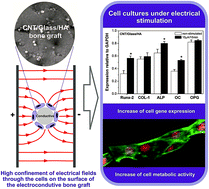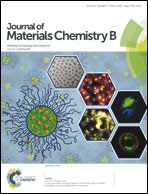Smart electroconductive bioactive ceramics to promote in situ electrostimulation of bone
Abstract
Biomaterials can still be reinvented to become simple and universal bone regeneration solutions. Following this roadmap, conductive CNT-based “smart” materials accumulate exciting grafting qualities for tuning the in vitro cellular phenotype. Biphasic electrical stimulation of human osteoblastic cells was performed in vitro on either dielectric bioactive bone grafts or conductive CNT-reinforced composites. The efficiency of the electrical stimuli delivery, as well as the effect of stimulation on cellular functions were investigated. Conductive substrates boosted the local culture medium conductivity and the confinement of the exogenous electrical fields. Hence, bone cell proliferation, DNA content and mRNA expression were maximized on the conductive substrates yielding superior stimuli delivering efficiency over dielectric ones. These findings are suggestive that bioactive bone grafts with electrical conductivity are capable of high spatial and temporal control of bone cell stimulation.


 Please wait while we load your content...
Please wait while we load your content...